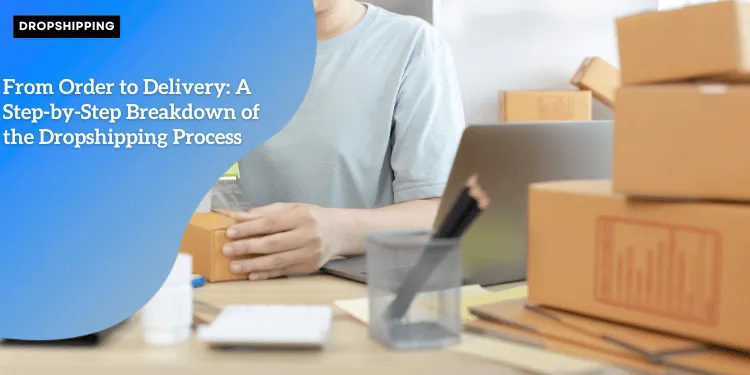From Order to Delivery: A Step-by-Step Breakdown of the Dropshipping Process

Anúncios
What is Dropshipping?
Dropshipping is a retail strategy where stores sell products to consumers without maintaining any physical inventory.
Essentially, when a customer makes a purchase, the store orders that item from a third-party supplier, who then takes care of storing, packaging, and shipping the product directly to the customer.
This strategy reduces the upfront costs associated with stocking inventory and managing warehousing, allowing entrepreneurs to operate their businesses with minimal financial risk.
Key Benefits of the Dropshipping Business Model
There are several key advantages to using the dropshipping model:
Anúncios
| Benefit | Before | After (Dropshipping) |
|---|---|---|
| 💰 Low Startup Costs | Need to invest heavily in inventory upfront | No need for inventory upfront, significantly reducing initial investment |
| 🏢 Reduced Overhead | Costs associated with warehousing, storage, and shipping | No warehousing or shipping responsibilities, reducing operational costs |
| 🌍 Flexible Location | Limited to a fixed business location | Manage your store from anywhere with an internet connection |
| 🛒 Wide Selection of Products | Limited product selection due to inventory constraints | Offer a vast range of products without the need to stock inventory |
| 📈 Scalability | Scaling involves handling more inventory and logistics | Easily scale by increasing marketing efforts without logistical bottlenecks |
Why Dropshipping Appeals to New Entrepreneurs
Dropshipping is particularly appealing to new entrepreneurs due to several reasons:
| Benefit | Before | After (Dropshipping) |
|---|---|---|
| ⚖️ Minimal Risk | High financial risks due to upfront inventory investment | Low financial barrier to entry, allowing testing of the market without significant investment |
| 🔧 Simplicity in Operations | Inventory and logistics management can be complex and time-consuming | Supplier handles inventory and shipping, simplifying business operations |
| 📣 Focus on Marketing & Sales | Time spent managing inventory and shipping distracts from marketing | Focus can shift to marketing, sales, and customer experience |
| 📚 Learning Opportunity | Starting a business often involves large risks and steep learning curves | Dropshipping provides a practical platform for learning with lower stakes |
These benefits, combined with the straightforward process of establishing a store and finding suppliers, make dropshipping a highly attractive business model for aspiring entrepreneurs seeking to make their mark in the e-commerce industry.
Setting Up Your Dropshipping Business
Finding and Partnering with Reliable Dropshipping Suppliers
The first step in setting up your dropshipping business is to partner with reliable suppliers.
Anúncios
Look for suppliers who offer the products you want to sell and have a reputation for quality and reliability.
Platforms like DSers, Spocket, and AutoDS can connect you with a variety of suppliers.
These platforms can simplify finding suppliers by providing access to a wide range of products and automating supplier communications.
Creating an Online Store and Determining Product Pricing
Next, you’ll need to create an online store.
You can use e-commerce platforms like Shopify, WooCommerce, or BigCommerce to build your store.
When setting up your store, pay attention to the aesthetics and usability to ensure a seamless customer experience.
During this stage, it’s crucial to determine your product pricing strategy.
Consider your supplier’s price, shipping costs, and the margin you aim to achieve.
Competitive pricing can attract more customers, but ensure it covers all costs to maintain profitability.
Integrating Dropshipping Apps for Automated Operations
To streamline your operations, integrating dropshipping apps is essential.
These apps automate various tasks, such as inventory management, order forwarding, and updating product listings.
Popular dropshipping apps include DSers, which connects Shopify stores to AliExpress, and Spocket, featuring suppliers from the US, Europe, and other regions.
By automating these processes, you can focus on other aspects of your business, like marketing, customer service, and scaling your store.
Automation ensures efficiency and accuracy, reducing the risk of errors and improving customer satisfaction.
Setting up your dropshipping business involves crucial steps like finding reliable suppliers, creating an engaging online store, and integrating useful apps for a seamless operation.
With these foundations, you’re well on your way to running a successful dropshipping business.
 From Order to Delivery
From Order to Delivery
The Customer Purchase Journey
The customer purchase journey in a dropshipping business begins with the first interaction your customer has with your online store.
This journey involves several key steps that ensure a seamless experience from browsing to delivery.
How Customers Interact with Your Online Store
Your customer’s journey starts on your online store’s homepage.
To create an engaging experience, ensure your site is user-friendly and visually appealing.
Easy navigation, high-quality product photos, and comprehensive descriptions are crucial.
The aim is to offer all the necessary information to help your customer make an informed purchasing decision.
The Checkout and Payment Process
Once a customer decides to buy, they proceed to the checkout process.
A streamlined and straightforward checkout process is crucial to avoid cart abandonment.
Allow guests to check out without creating an account if possible.
Ensure your checkout page is secure and supports multiple payment methods, such as credit cards, PayPal, and other digital wallets.
Order Confirmation and Customer Communication
After the checkout and payment process, immediately send an order confirmation.
This email should include details like the order number, product information, estimated delivery time, and a link to track the order.
Timely and clear communication helps build customer trust.
Properly managing the customer purchase journey ensures smooth interactions on your online store and creates a solid foundation for future customer loyalty.
Behind the Scenes: Order Processing
Automated Order Forwarding to Suppliers
Once a customer places an order on your dropshipping store, the real magic happens behind the scenes.
Automated order forwarding ensures that the order details are instantly sent to your dropshipping supplier.
This process is typically managed through dropshipping apps like DSers, Spocket, or Collective, which integrate seamlessly with your online store.
These apps handle the heavy lifting, forwarding order details such as product specifications, shipping address, and other necessary information directly to the supplier.
This automation enhances efficiency, allowing you to focus on other aspects of your business.
Supplier’s Role in Order Preparation and Packaging
After receiving the order details, your supplier takes over, stepping into the role of order fulfillment.
They pick, pack, and prepare the products for shipment.
This involves checking the order details for accuracy, selecting the right products, and securely packaging them to ensure safe delivery.
Suppliers often have systems in place to streamline this process, minimizing the chance of errors and ensuring timely preparation of orders.
Reliable suppliers understand the importance of speed and efficiency in maintaining customer satisfaction.
Customization Options: Branded Invoices and Custom Packaging
One distinctive advantage offered by many dropshipping suppliers is the ability to customize order shipments.
This includes options for branded invoices, custom packaging, and even personalized notes.
These customization offerings can elevate the unboxing experience for your customers, enhancing your brand’s presence and fostering customer loyalty.
For instance, branded invoices might feature your store’s logo and contact information, creating a seamless brand experience.
Custom packaging options can also provide a unique touch, setting your business apart in a competitive e-commerce landscape.
By understanding and optimizing each of these behind-the-scenes processes, you ensure that orders are handled efficiently and meet your customers’ expectations.
This meticulous attention to order processing not only streamlines your operations but also establishes a strong foundation for customer trust and satisfaction.
Delivery and After-Sales Support
Direct Shipping from Supplier to Customer
Once your customer’s order has been processed and forwarded to the supplier, the next crucial step is shipping.
The supplier prepares and packages the product, then ships it directly to the customer.
This direct shipping eliminates the need for you to handle physical inventory, saving significant time and resources.
Handling Customer Service Responsibilities
An essential part of maintaining a successful dropshipping business is managing customer service.
Even though the supplier handles shipping, it’s your responsibility to address customer inquiries, resolve any issues, and provide timely updates on order status.
Effective customer service involves:
- ⏱️ Quickly responding to queries and complaints
- 📦 Offering clear and accurate information about order status
- ⏳ Managing expectations regarding shipping times and potential delays
Managing Customer Satisfaction and Support Inquiries
Customer satisfaction is key to the success of your dropshipping business.
Here are a few ways to ensure high customer satisfaction:
- ⏰ Timely Communication: Keep your customers informed about their order status and any potential delays.
- 🔍 Quality Control: Regularly review feedback regarding the quality of products supplied.
- 🔄 Returning and Refunds: Outline a clear and fair return policy for your customers. While the supplier handles returns, you play a crucial role in facilitating a smooth returns process.
Keeping these aspects of delivery and after-sales support in check not only helps in building trust but also ensures customer loyalty.
The nuances of customer service and managing satisfaction lead directly into the next consideration: leveraging tools and technologies to streamline your operations.
Tools and Technologies
Popular Dropshipping Apps
Selecting the right tools and technologies can streamline and enhance your dropshipping business.
There are several popular dropshipping apps that can help automate and manage various aspects of your operations:
- 🛒 Collective: This app is designed for Shopify merchants, allowing them to sell products from top Shopify brands. It simplifies inventory updates and streamlines the order forwarding process.
- 🔗 DSers: DSers connects Shopify stores to AliExpress, facilitating product imports and order automation. With DSers, you can manage multiple suppliers and orders efficiently.
- 🌍 Spocket: Spocket includes suppliers from various regions such as the US, Europe, Brazil, and India, providing access to a diverse range of products. It offers features like one-click order fulfillment and branded invoicing.
Automation Features for Inventory and Order Management
Automation is key to the efficiency of a dropshipping business.
Dropshipping apps integrate various automation features to reduce manual tasks:
- 📦 Inventory Management: Apps like DSers and Spocket automatically update product listings based on supplier availability. This ensures that your online store always reflects the current stock status, preventing overselling.
- 🛒 Order Management: When a customer places an order, these apps can automatically forward the order details to the supplier, who then prepares and ships the product. This automation significantly reduces the time and effort required for order processing.
Integration with E-commerce Platforms
A seamless integration between dropshipping apps and e-commerce platforms is essential for smooth operations.
Most dropshipping tools are designed to integrate effortlessly with leading e-commerce platforms like Shopify, WooCommerce, and BigCommerce.
- 🛒 Shopify: This platform offers a wide range of integrations with dropshipping apps like Collective and DSers, making it an ideal choice for many dropshippers. The integration allows for easy setup, management, and scaling of your online store.
- 🔧 WooCommerce: As a flexible and customizable platform, WooCommerce supports numerous dropshipping plugins, ensuring that you can tailor your online store to meet your specific needs.
- 🚀 BigCommerce: Known for its robust features and scalability, BigCommerce also integrates well with various dropshipping apps, enabling efficient product listing and order management.
By leveraging these tools and technologies, you can optimize your dropshipping business operations, making it easier to manage inventory, process orders, and ensure timely delivery to customers while maintaining a high level of service.
